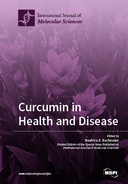Explore

Curcumin in Health and Disease
0 Ungluers have
Faved this Work
Login to Fave
The plant-derived polyphenol curcumin has been used in promoting health and combating disease for thousands of years. Its therapeutic effects have been successfully utilized in Ayurvedic and Traditional Chinese Medicine in order to treat inflammatory diseases. Current results from modern biomolecular research reveal the modulatory effects of curcumin on a variety of signal transduction pathways associated with inflammation and cancer. In this context, curcumin’s antioxidant, anti-inflammatory, anti-tumorigenic, and even anti-metastatic activities are discussed. On the cellular level, the reduced activity of several transcription factors (such as NFkB or AP-1) and the suppression of inflammatory cytokines, matrix degrading enzymes, metastasis related genes and even microRNAs are reported. On functional levels, these molecular effects translate into reduced proliferative, invasive, and metastatic capacity, as well as induced tumor cell apoptosis. All these effects have been observed not only in vitro but also in animal models. In combination with anti-neoplastic drugs like Taxol, kinase inhibitors, and radiation therapy, curcumin potentiates the drugs’ therapeutic power and can protect against undesired side effects. Natural plant-derived compounds like curcumin have one significant advantage: They do not usually cause side effects. This feature qualifies curcumin for primary prevention in healthy persons with a predisposition to cancer, arteriosclerosis, or chronic inflammatory diseases. Nonetheless, curcumin is considered safe, although potential toxic effects stemming from high dosages, long-term intake, and pharmacological interactions with other compounds have yet to be assessed. This Special Issue examines in detail and updates current research on the molecular targets, protective effects, and modes of action of natural plant-derived compounds and their roles in the prevention and treatment of human diseases.
This book is included in DOAB.
Why read this book? Have your say.
You must be logged in to comment.
Rights Information
Are you the author or publisher of this work? If so, you can claim it as yours by registering as an Unglue.it rights holder.Downloads
This work has been downloaded 327 times via unglue.it ebook links.
- 258 - pdf (CC BY-NC-ND) at Unglue.it.
Keywords
- ageing
- Akt/mTOR signaling
- Alzheimer’s disease
- amino-acids
- amyloid
- amyloidosis
- anti-cancer
- anti-inflamation
- anti-tumor
- anticancer
- antimicrobial agents
- antioxidant activity
- Antioxidants
- Apoptosis
- Autophagy
- brain ischemia
- Cancer
- cancer treatment
- cell cycling
- cellular pathway
- centrifugal partition chromatography
- chaperone-mediated autophagy
- chitosan
- Complementary Medicine
- Crohn’s disease
- Curcuma longa
- curcumin
- death receptor
- delivery system
- Diet
- direct protein binding
- Drug Discovery
- gastric cancer
- gastric ulcer
- gastroprotection
- Genes
- glioblastoma multiforme
- Helicobacter pylori
- hydrostatic counter-current chromatography
- IL-17
- ImageJ
- inflamm-aging
- inflammatory bowel disease
- macronutrients
- mechanism of action
- metabolic reprogramming
- microbiota
- Micronutrients
- Minerals
- mitophagy
- n/a
- Nanoparticles
- Necrotizing enterocolitis
- neurodegeneration
- Nutrition
- oxidative metabolites
- protein aggregation
- protein misfolding
- reflux esophagitis
- renal cell cancer
- senescence
- senolytics
- SHMT2
- silica
- STAT3
- structure activity relationship
- Supportive Care
- tau protein
- TLC bioautography
- TLC-MS
- transmission electron microscopy
- transthyretin
- tumor growth
- tumor proliferation
- turmeric tuber
- ulcerative colitis
- Vitamins
- wound
- Wound healing
- Zingiberaceae
Links
DOI: 10.3390/books978-3-03921-450-1Editions


